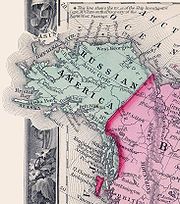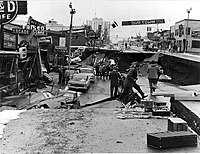History of Alaska
The name "Alaska" derives from the Aleut word Alaxsxaq (also spelled Alyeska), meaning "mainland" (literally, "the object toward which the action of the sea is directed").
In 1989, the Exxon Valdez hit a reef in Prince William Sound, spilling between 11 and 34 million US gallons (42,000 and 129,000 m3) of crude oil over 1,100 miles (1,800 km) of coastline.
[2] The coastal migrants from Asia were probably the first wave of humans to cross the Bering land bridge in western Alaska, and many of them initially settled in the interior of what is now Canada.
This missionary activity would continue into the 19th century, ultimately becoming the most visible trace[citation needed] of the Russian colonial period in present-day Alaska.
In 1775 Bruno de Hezeta led an expedition; the Sonora, under Bodega y Quadra, ultimately reached latitude 58° north, entered Sitka Sound and formally claimed the region for Spain.
The 1779 expedition of Ignacio de Arteaga and Bodega y Quadra reached Port Etches on Hinchinbrook Island, and entered Prince William Sound.
The crisis was resolved in Madrid by the Nootka Conventions of 1790–1794, which provided that traders of both Britain and Spain could operate on the northwest coast, that the captured British ships would be returned and an indemnity paid.
Captain James Cook, midway through his third and final voyage of exploration in 1778, sailed along the west coast of North America aboard HMS Resolution, from then-Spanish California all the way to the Bering Strait.
In 1799, Shelikhov's son-in-law, Nikolay Petrovich Rezanov, acquired a monopoly on the American fur trade from emperor Paul I and formed the Russian-American Company.
In 1896, the discovery of gold in Yukon Territory in neighboring Canada, brought many thousands of miners and new settlers to Alaska, and very quickly ended the nation's four year economic depression.
Soapy Smith, a crime boss confidence man who operated the largest criminal empire in gold rush era Alaska, was shot down by vigilantes in the famed Shootout on Juneau Wharf.
James Wickersham, a Delegate to Congress, introduced Alaska's first statehood bill, but it failed due to the small population and lack of interest from Alaskans.
This situation created an atmosphere of enmity among Alaskans who watched the wealth being generated by their labors flowing into the hands of Seattle business holdings.
Colonists were largely from northern states, such as Michigan, Wisconsin, and Minnesota under the belief that only those who grew up with climates similar to that of Alaska's could handle settler life there.
The United Congo Improvement Association asked the president to settle 400 African American farmers in Alaska, saying that the territory would offer full political rights, but racial prejudice and the belief that only those from northern states would make suitable colonists caused the proposal to fail.
The exploration and settlement of Alaska would not have been possible without the development of the aircraft, which allowed for the influx of settlers into the state's interior, and rapid transportation of people and supplies throughout.
[13] Attu was regained in May 1943 after two weeks of intense fighting and 3,829 American casualties:[14] 549 were killed, 1,148 were injured, 1,200 had severe cold injuries, 614 succumbed to disease, and 318 died of miscellaneous causes.
After the war, the Native Attuans who had survived their internment were resettled to Atka by the federal government, which considered their home villages too remote to defend.
[19] Pioneering conditions in Alaska awoke ingenuity leading to invention of the Alaskan sawmill, an attachment to a chainsaw letting it be used to cut a felled tree into neat parallel-sided planks or boards.
He stated that the motto "...is a reminder that beyond the horizon of urban clutter there is a Great Land beneath our flag that can provide a new tomorrow for this century's 'huddled masses yearning to be free'."
[22] In the mid-1960s, Alaska Natives from many tribal groups had united in an effort to gain title to lands wrested from them by Europeans, but the government had responded slowly before the Prudhoe Bay discovery.
The government finally took action when permitting for a pipeline crossing the state, necessary to get Alaskan oil to market, was stalled pending the settlement of Native land claims.
Though a pipeline from the North Slope to the nearest ice-free port, almost 800 miles (1,300 km) to the south, was the only way to get Alaska's oil to market, significant engineering challenges lay ahead.
Between the North Slope and Valdez, there were active fault lines, three mountain ranges, miles of unstable, boggy ground underlain with frost, and migration paths of caribou and moose.
Tourism became popular after World War II, when military personnel stationed in the region returned home praising its natural splendor.
On March 24, the tanker Exxon Valdez ran aground in Prince William Sound, releasing 11 million gallons of crude oil into the water, spreading along 1,100 miles (1,800 km) of shoreline.
Government studies show that the oil and the cleaning process itself did long-term harm to the ecology of the Sound, interfering with the reproduction of birds and animals in ways that still aren't fully understood.
The ADEC issued a second report reinforcing the original findings but conceded the lack of cost data from Teck Cominco made it impossible to evaluate the impact of SCR on the mine's profitability.
Studies performed by the US Geological Survey have shown that the "1002 area" of ANWR, located just east of Prudhoe Bay, contains large deposits of crude oil.
In the 1990s and first decade of the 21st century, votes about the status of the refuge occurred repeatedly in the U.S. House and Senate, but as of 2007 efforts to allow drilling have always been ultimately thwarted by filibusters, amendments, or vetoes.














